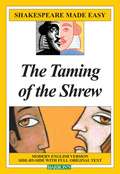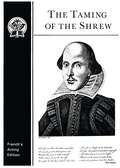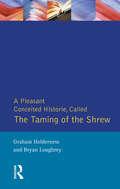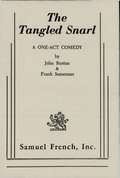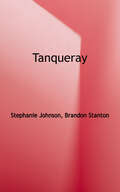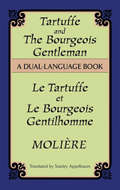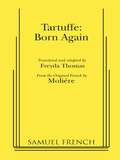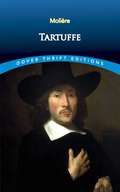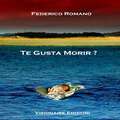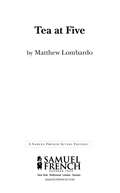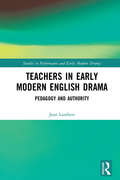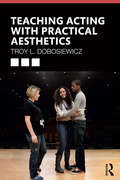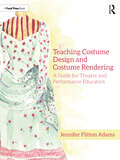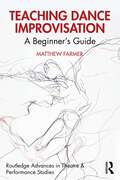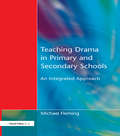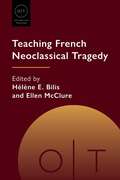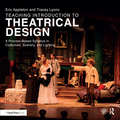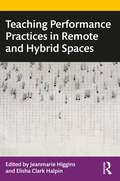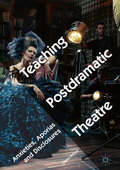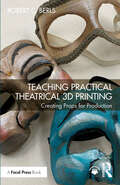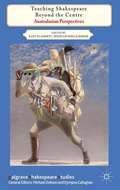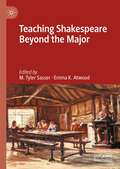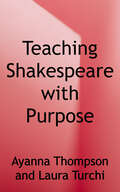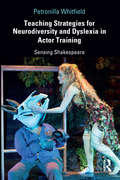- Table View
- List View
Taming of the Shrew (Shakespeare Made Easy)
by William ShakespeareA Simon & Schuster eBook. Simon & Schuster has a great book for every reader.
Taming of the Shrew (Skillan)
by William Shakespeare George SkillanFrench's Acting Edition of Shakespeare's Classic Play
Taming of the Shrew: First Quarto of "Taming of a Shrew" (Shakespearean Originals--first Editions Ser.)
by Graham Holderness Bryan LoughreyFirst Published in 1992. This series puts into circulation single annotated editions of early modern play-texts whose literary and theatrical histories have been overshadowed by editorial practices dominant since the eighteenth century. The text contained in this volume is not what we know as Shakespeare's The Taming of the Shrew, modern editions of which play are all derived from the text printed in the 1623 First Folio edition of Shakespeare's works. The present text is an edition of the play published in 1594 under the title The Taming of a Shrew, which has always been denied the authorising signature of 'Shakespeare', and regarded as an earlier version by another dramatist or as a pirated and corrupt 'memorial reconstruction' of Shakespeare's The Taming of the Shrew.
Tangled Snarl: The Tangled Snarl Ii
by John RustanComedy / 2m, 2f, 1 boy / Interior / To Private Detective Spuds Idaho, life in L.A. is a 24 hour race around a track made of quicksand. When the dying Legs Flamingo leaves him a package to deliver, Spuds gets curious. Why is Leslie Detweiler more interested in the package than in the death of her husband: "Excuse me, but you look pretty collected for a lady whose breadwinner just got sliced four ways." Why was Legs mixed up with mob figure Vito "Fingers" Scampi: "So Fingers had Legs under this thumb." And how did it figure in with the Krieger heist: "The Commissioner was embarrassed. His boys in blue were red in the face." With the aid of his secretary, Ginny, and a wise cracking kid, it all untangles for Spuds Idaho.
Tanqueray
by Stephanie Johnson Brandon Stanton"A deeply touching memoir . . . A beautiful, sometimes shocking NC-17 story, kept out of the lily-white, upper crust canon of literature--until now."" --The Washington Post The storytelling phenomenon Humans of New York and its #1 bestselling books have captivated a global audience of millions with personal narratives that illuminate the human condition. But one story stands apart from the rest... She is a woman as fabulous, unbowed, and irresistible as the city she lives in. Meet TANQUERAY. In 2019, Humans of New York featured a photo of a woman in an outrageous fur coat and hat she made herself. She instantly captured the attention of millions. Her name is Stephanie Johnson, but she's better known to HONY followers as ""Tanqueray,"" a born performer who was once one of the best-known burlesque dancers in New York City. Reeling from a brutal childhood, immersed in a world of go-go dancers and hustlers, dirty cops and gangsters, Stephanie was determined to become the fiercest thing the city had ever seen. And she succeeded. Real, raw, and unapologetically honest, this is the full story of Tanqueray as told by Brandon Stanton--a book filled with never-before-told stories of Tanqueray's struggles and triumphs through good times and bad, personal photos from her own collection, and glimpses of New York City from back in the day when the name "Tanqueray" was on everyone's lips."
Tartuffe and the Bourgeois Gentleman: A Dual-Language Book
by MolièreOften called the "Father of French Comedy," Molière (Jean-Baptiste Poquelin, 1622-1673) was a master at exposing the foibles and complexities of humanity in plays notable for their dramatic construction, varied and diverse humor, and subtlety of psychological observation. This convenient dual-language volume contains the original French texts and English translations of two of Molière's most praised and popular comedies: Tartuffe and The Bourgeois Gentleman. These timeless theatrical works by one of France's greatest and most influential playwrights can be appreciated not only by students of French language and literature but by any aficionado of classic comedy.Tartuffe, a 1664 verse comedy with serious overtones, concerns a scoundrel who impersonates a holy man in order to acquire his gullible host's property and wife. The prose farce The Bourgeois Gentleman, an instant success at its 1670 debut, lampoons the hypocrisy of 17th-century Parisian society with a central character who attempts to adopt the superficial manners, accomplishments, and speech associated with the nobility. Both plays abound in humor, the quips of saucy servants, and a host of satirical plot devices.For this edition, Stanley Appelbaum has provided an informative introduction to the playwright and the plays, and excellent literal English translations on facing pages, offering students an ideal opportunity both to refine their French-language skills and to enjoy Molière in his own words.
Tartuffe or the Hypocrite
by Molière Curtis Hidden PageTartuffe a "man of God" uses his connections to swindle his generous host Orgon out of his wealth and his wife. [This text is listed as an example that meets Common Core Standards in English language arts in grades 11-12 at http://www.corestandards.org.]
Tartuffe: Born Again
by MoliereThis modern adaptation casts Tartuffe as a deposed televangelist who rooks Orgon and his family of their money and property and nearly compromises Orgon's wife. The action takes place in a religious television studio in Baton Rouge where the characters cavort to either prevent or aid Tartuffe in his machinations. Written in modern verse, Tartuffe: Born Again adheres closely to the structure and form of the original. Moliere's legendary comedic characters are delightfully at home in this modern day version that played at New York's Circle in the Square.
Tartuffe: Les Précieuses Ridicules, George Dandin... (Dover Thrift Editions: Plays)
by MolièreRenowned for his satirical works, Molière (Jean-Baptiste Poquelin, 1622–1673) delighted in lampooning the social pretensions and conceits of 17th-century French society. In this 1664 verse comedy with serious overtones, Tartuffe, a penniless scoundrel and religious poseur, is invited by a gullible benefactor to live in his home.Imposing a rigidly puritanical regimen on the formerly happy household, Tartuffe wreaks havoc among family members. He breaks off the daughter's engagement, attempts to seduce the wife of his host, acquires his patron's property, and eventually resorts to blackmail and extortion. But ultimately, his schemes and malicious deeds lead to his own downfall.Attacked by the Church and twice suppressed, Tartuffe opened to packed houses in 1669. Teeming with lively humor and satirical plot devices, this timeless comedy by one of France's greatest and most influential playwrights is essential reading for students of theater and literature.
Te Gusta Morir?
by Federico RomanoDoce historias en primera y tercera persona, los personajes se mueven a lo largo de un hilo intentando mantener el equilibrio entre la fantasía y la realidad.
Tea at Five: [a Play]
by Matthew Lombardo1f / Biographical monologue / Tea at Five captures the fiery spirit of Katherine Hepburn in a one-woman show that recounts her journey from a well-heeled Yankee childhood to winner of four Oscars. Ensconced at her beloved Fenwick home, Ms. Hepburn reflects on the dizzying heights and emotional lows of her upbringing, her adventures in show business and her heartbreaking romance with Spencer Tracy. Audiences leave with new memories of one of the most dearly loved ladies of an era.
Teachers in Early Modern English Drama: Pedagogy and Authority (Studies in Performance and Early Modern Drama)
by Jean LambertStarting from the early modern presumption of the incorporation of role with authority, Jean Lambert explores male teachers as representing and engaging with types of authority in English plays and dramatic entertainments by Shakespeare and his contemporaries from the late sixteenth to the early seventeenth century. This book examines these theatricalized portraits in terms of how they inflect aspects of humanist educational culture and analyzes those ideas and practices of humanist pedagogy that carry implications for the traditional foundations of authority. Teachers in Early Modern English Drama is a fascinating study through two centuries of teaching Shakespeare and his contemporaries and will be a valuable resource for undergraduates, postgraduates, and scholars interested in sixteenth- and seventeenth-century drama, writing, and culture.
Teaching Acting with Practical Aesthetics
by Troy DobosiewiczTeaching Acting with Practical Aesthetics uses constructivist pedagogy to teach acting via Practical Aesthetics, a system of actor training created in the mid-1980s by David Mamet. The book melds the history of Practical Aesthetics, Practical Aesthetics itself, educational theory, and compatible physical work into the educational approach called Praxis to create a comprehensive training guide for the modern actor and theatre instructor. It includes lesson plans, compatible voice and movement exercises, constructivist teaching materials, classroom handouts, and a suggested calendar for Acting courses. Written for Acting instructors at the college and secondary levels, Acting scholars, and professionals looking for a new way to perform, Teaching Acting with Practical Aesthetics offers detailed instructions to help students sharpen their performing skills and excel on stage.
Teaching Costume Design and Costume Rendering: A Guide for Theatre and Performance Educators
by Jennifer Flitton AdamsTeaching Costume Design and Costume Rendering: A Guide for Theatre and Performance Educators clarifies the teaching process for Costume Design and Costume Rendering courses and offers a clear and tested path to success in the classroom. Drawing on the knowledge and experience of the author’s twenty-five years of teaching as well as many decades of work by multiple other educators, this book provides a clear roadmap for teaching these two popular Theatre courses. It includes information on pedagogical theory, creating syllabi, preparing and structuring classes, crafting lectures, and analyzing students’ work, with a heavy focus on specific teaching projects that have been proven to work in the classroom. All aspects of teaching costume design and rendering are considered, including body awareness, cultural sensitivities, script analysis, elements and principles of design, psychology of dress, choosing fabrics, period styling, and requirements of dance costumes. Included in the appendices are sample syllabi, and additional reading and research resources. Teaching Costume Design and Costume Rendering is a guide for theatre and performance educators ranging from secondary education to undergraduate programs and graduate studies. It is a valuable resource both for costume educators approaching costume design and rendering classes for the first time and for experienced instructors looking for new material for these courses.
Teaching Dance Improvisation: A Beginner's Guide (ISSN)
by Matthew FarmerTeaching Dance Improvisation serves as an introduction to, and a springboard for the author’s theories, practices, and curriculum building of dance improvisation as a technique. By taking a similar approach to teaching ballet, modern, jazz, tap, or hip hop, this book supplies its reader with an easy-to-follow roadmap in order to begin building and incorporating dance improvisation into dance studios/classrooms and curriculums.
Teaching Drama in Primary and Secondary Schools: An Integrated Approach
by Michael FlemingThis book will be of major interest to student teachers, teachers, lecturers and researchers. It provides a case for an integrated approach to the teaching of drama in primary and secondary schools that will help practitioners develop a theoretical rationale for their work. It also offers practical examples of lesson plans and schemes of work designed to give pupils a broad and balanced experience of drama. These are presented within a framework that argues for an integration of content and form, means and ends, and internal and external experience.Whereas the author's previous work argued for an inclusive approach that reconciled polarized views about performance drama and improvisation, this book shows how those activities can be related to each other in practice in an integrated curriculum.
Teaching French Neoclassical Tragedy (Options for Teaching #55)
by Hélène E. Bilis and Ellen McClureTragedy has been reborn many times since antiquity. Seventeenth-century French playwrights composed tragedies marked by neoclassical aesthetics and the divine-right absolutism of the Grand Siècle. But their works also speak to the modern imagination, inspiring reactions from Barthes, Derrida, and Foucault; adaptations and reworkings by Césaire and Kushner; and new productions by francophone and anglophone directors.This volume addresses both the history of French neoclassical tragedy--its audiences, performance practice, and development as a genre--and the ideas these works raise, such as necessity, free will, desire, power, and moral behavior in the face of limited choices. Essays demonstrate ways to teach the plays through a variety of lenses, such as performance, spectatorship, aesthetics, rhetoric, and affect. The book also explores postcolonial engagement, by writers and directors both in and outside France, with these works.
Teaching Introduction to Theatrical Design: A Process Based Syllabus in Costumes, Scenery, and Lighting
by Eric Appleton Tracey LyonsTeaching Introduction to Theatrical Design is a week-by-week guide that helps instructors who are new to teaching design, teaching outside of their fields of expertise, or looking for better ways to integrate and encourage non-designers in the design classroom. This book provides a syllabus to teach foundational theatrical design by illustrating process and application of the principals of design in costumes, sets, lights, and sound.
Teaching Performance Practices in Remote and Hybrid Spaces
by Jeanmarie HigginsThis collection of insightful essays gives teachers’ perspectives on the role of space and presence in teaching performance. It explores how the demand for remote teaching can be met while at the same time successfully educating and working compassionately in this most ‘live’ of disciplines. Teaching Performance Practices in Remote and Hybrid Spaces reframes prevailing ideas about pedagogy in dance, theatre, and somatics and applies them to teaching in face-to-face, hybrid, and remote situations. Case studies from instructors and professors provide essential, practical suggestions for remotely teaching a vast range of studio courses, including tap dance, theatre design, movement, script analysis, and acting, rendering this book an invaluable resource. The challenges that teachers are facing in the early twenty-first century are addressed throughout, helping readers to navigate these unprecedented circumstances whilst delivering lessons, guiding workshops, rehearsing, or even staging performances. This book is invaluable for dance and theatre teachers or leaders who work in the performing arts and related disciplines. It is also ideal for any professionals who need research-based solutions for teaching performance online.
Teaching Postdramatic Theatre: Anxieties, Aporias and Disclosures
by Glenn D’CruzThis book explores the concept and vocabulary of postdramatic theatre from a pedagogical perspective. It identifies some of the major anxieties and paradoxes generated by teaching postdramatic theatre through practice, with reference to the aesthetic, cultural and institutional pressures that shape teaching practices. It also presents a series of case studies that identify the pedagogical fault lines that expose the power-relations inherent in teaching (with a focus on the higher education sector as opposed to actor training institutions). It uses auto-ethnography, performance analysis and critical theory to assist university teachers involved in directing theatre productions to deepen their understanding of the concept of postdramatic theatre.
Teaching Practical Theatrical 3D Printing: Creating Props for Production
by Robert C. BerlsTeaching Practical Theatrical 3D Printing: Creating Props for Production is a cohesive and practical guide for instructors teaching 3D printing techniques in stagecraft, costume and props courses.Written for the instructor, this book uses non-technical language to explain 3D printers, their workflows and products. Coverage includes the ins and outs of multiple filaments, pros and cons of different types of printers, shop or laboratory setup and safety concerns. The book features lesson plans, rubrics and class-tested sample student projects from design to finished product that highlight learning objectives and methodologies, as well as software and hardware usage explanations and common problems that can occur within design and printing. Step-by-step instructions are included for many types of projects, including fake noses, candlestick phones, buttons, 3D scans, historical recreations and linear actuators. The book also contains examples of poor, average and excellent work with grading explanations and guidance on how to help the student move to the next level with their projects. Chapter objectives, chapter summaries, checklists and reflection points facilitate an instructor in gaining confidence with 3D printers and incorporating their use in the classroom.Teaching Practical Theatrical 3D Printing is an excellent resource for instructors of Props and Costume Design and Construction courses that are interested in using state of the art tools and technology for theatre production.Fully editable files for every object featured in the book are available at www.routledge.com/9781032453279, allowing readers to jump-start their projects and giving them the flexibility to change and redesign the items to best fit their needs.
Teaching Shakespeare Beyond the Centre
by Penny Gay Kate Flaherty L. E. SemlerShowcasing a wide array of recent, innovative and original research into Shakespeare and learning in Australasia and beyond, this volume argues the value of the 'local' and provides transferable and adaptable models of educational theory and practice.
Teaching Shakespeare Beyond the Major
by M. Tyler Sasser Emma K. AtwoodThis edited collection considers the task of teaching Shakespeare in general education college courses, a task which is often considered obligatory, perfunctory, and ancillary to a professor’s primary goals of research and upper-level teaching. The contributors apply a variety of pedagogical strategies for teaching general education students who are often freshmen or sophomores, non-majors, and/or non-traditional students. Offering instructors practical classroom approaches to Shakespeare’s language, performance, and critical theory, the essays in this collection explicitly address the unique pedagogical situations of today’s general education college classroom.
Teaching Shakespeare With Purpose: A Student-centred Approach
by Ayanna Thompson Laura TurchiWhat does it mean to teach Shakespeare with purpose? It means freeing teachers from the notion that teaching Shakespeare means teaching everything, or teaching "Western Civilisation" and universal themes. Instead, this invigorating new book equips teachers to enable student-centred discovery of these complex texts. Because Shakespeare's plays are excellent vehicles for many topics --history, socio-cultural norms and mores, vocabulary, rhetoric, literary tropes and terminology, performance history, performance strategies -- it is tempting to teach his plays as though they are good for teaching everything. <p><p>This lens-free approach, however, often centres the classroom on the teacher as the expert and renders Shakespeare's plays as fixed, determined, and dead. Teaching Shakespeare with Purpose shows teachers how to approach Shakespeare's works as vehicles for collaborative exploration, to develop intentional frames for discovery, and to release the texts from over-determined interpretations. In other words, this book presents how to teach Shakespeare's plays as living, breathing, and evolving texts.
Teaching Strategies for Neurodiversity and Dyslexia in Actor Training: Sensing Shakespeare
by Petronilla WhitfieldTeaching Strategies for Neurodiversity and Dyslexia in Actor Training addresses some of the challenges met by acting students with dyslexia and highlights the abilities demonstrated by individuals with specific learning differences in actor training. The book offers six tested teaching strategies, created from practical and theoretical research investigations with dyslexic acting students, using the methodologies of case study and action research. Utilizing Shakespeare’s text as a laboratory of practice and drawing directly from the voices and practical work of the dyslexic students themselves, the book explores: the stress caused by dyslexia and how the teacher might ameliorate it through changes in their practice the theories and discourse surrounding the label of dyslexia the visual, kinaesthetic, and multisensory processing preferences demonstrated by some acting students assessed as dyslexic acting approaches for engaging with Shakespeare’s language, enabling those with dyslexia to develop their authentic voice and abilities a grounding of the words and the meaning of the text through embodied cognition, spatial awareness, and epistemic tools Stanislavski’s method of units and actions and how it can benefit and obstruct the student with dyslexia when working on Shakespeare Interpretive Mnemonics as a memory support and hermeneutic process, and the use of color and drawing towards an autonomy in live performance This book is a valuable resource for voice and actor training, professional performance, and for those who are curious about emancipatory methods that support difference through humanistic teaching philosophies.
